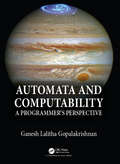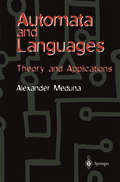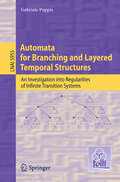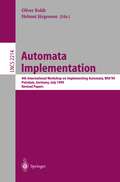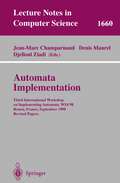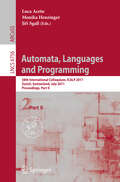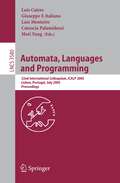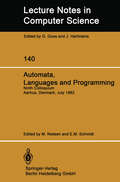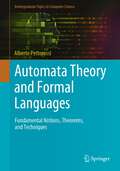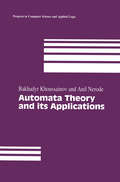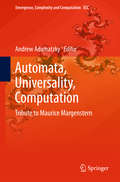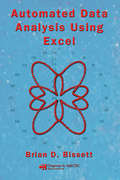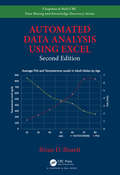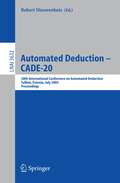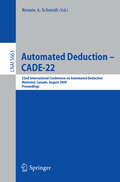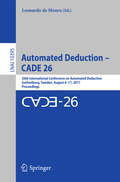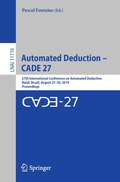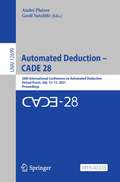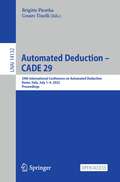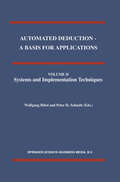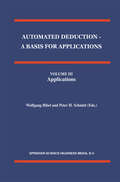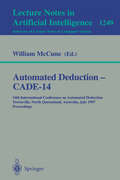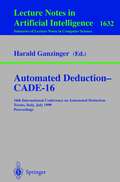- Table View
- List View
Automata and Computability: A Programmer's Perspective
by Ganesh GopalakrishnanAutomata and Computability is a class-tested textbook which provides a comprehensive and accessible introduction to the theory of automata and computation. The author uses illustrations, engaging examples, and historical remarks to make the material interesting and relevant for students. It incorporates modern/handy ideas, such as derivative-based parsing and a Lambda reducer showing the universality of Lambda calculus. The book also shows how to sculpt automata by making the regular language conversion pipeline available through a simple command interface. A Jupyter notebook will accompany the book to feature code, YouTube videos, and other supplements to assist instructors and studentsFeatures Uses illustrations, engaging examples, and historical remarks to make the material accessible Incorporates modern/handy ideas, such as derivative-based parsing and a Lambda reducer showing the universality of Lambda calculus Shows how to "sculpt" automata by making the regular language conversion pipeline available through simple command interface Uses a mini functional programming (FP) notation consisting of lambdas, maps, filters, and set comprehension (supported in Python) to convey math through PL constructs that are succinct and resemble math Provides all concepts are encoded in a compact Functional Programming code that will tesselate with Latex markup and Jupyter widgets in a document that will accompany the books. Students can run code effortlessly href="https://github.com/ganeshutah/Jove.git/"here.
Automata and Languages: Theory and Applications
by Alexander MedunaA step-by-step development of the theory of automata, languages and computation. Intended for use as the basis of an introductory course at both junior and senior levels, the text is organized so as to allow the design of various courses based on selected material. It features basic models of computation, formal languages and their properties; computability, decidability and complexity; a discussion of modern trends in the theory of automata and formal languages; design of programming languages, including the development of a new programming language; and compiler design, including the construction of a complete compiler. Alexander Meduna uses clear definitions, easy-to-follow proofs and helpful examples to make formerly obscure concepts easy to understand. He also includes challenging exercises and programming projects to enhance the reader's comprehension, and many 'real world' illustrations and applications in practical computer science.
Automata for Branching and Layered Temporal Structures: An Investigation into Regularities of Infinite Transition Systems (Lecture Notes in Computer Science #5955)
by Gabriele PuppisSince 2002, FoLLI awards an annual prize for an outstanding dissertation in the fields of Logic, Language, and Information. This book is based on the Ph.D. thesis of Gabriele Puppis, who was the winner of the E.W. Beth dissertation award for 2007. Puppis' thesis focuses on Logic and Computation and, more specifically, on automata-based decidability techniques for time granularity and on a new method for deciding Monadic Second Order theories of trees. The results presented represent a significant step towards a better understanding of the changes in granularity levels that humans make so easily in cognition of time, space, and other phenomena, whereas their logical and computational structure poses difficult conceptual and computational challenges.
Automata Implementation: 4th International Workshop on Implementing Automata, WIA'99 Potsdam, Germany, July 17-19, 2001 Revised Papers (Lecture Notes in Computer Science #2214)
by Oliver Boldt Helmut JürgensenAutomata Implementation: Third International Workshop on Implementing Automata, WIA'98, Rouen, France, September 17-19, 1998, Revised Papers (Lecture Notes in Computer Science #1660)
by Jean-Marc Champarnaud Denis Maurel Djelloul ZiadiThe papers contained in this volume were presented at the third international Workshop on Implementing Automata, held September 17{19,1998, at the U- versity of Rouen, France. Automata theory is the cornerstone of computer science theory. While there is much practical experience with using automata, this work covers diverse - eas,includingparsing,computationallinguistics,speechrecognition,textsear- ing,device controllers,distributed systems, andprotocolanalysis.Consequently, techniques that have been discovered in one area may not be known in another. In addition, there is a growing number of symbolic manipulation environments designed to assist researchers in experimenting with and teaching on automata and their implementation; examples include FLAP, FADELA, AMORE, Fire- Lite, Automate, AGL, Turing’s World, FinITE, INR, and Grail. Developers of such systems have not had a forum in which to expose and compare their work. The purpose of this workshop was to bring together members of the academic, research,andindustrialcommunitieswithaninterestinimplementingautomata, to demonstrate their work and to explain the problems they have been solving. These workshops started in 1996 and 1997 at the University of Western Ontario, London, Ontario, Canada, prompted by Derick Wood and Sheng Yu. The major motivation for starting these workshops was that there had been no single forum in which automata-implementation issues had been discussed. The interest shown in the r st and second workshops demonstrated that there was a need for such a forum. The participation at the third workshop was very interesting: we counted sixty-three registrations, four continents, ten countries, twenty-three universities, and three companies.
Automata, Languages and Programming: 38th International Colloquium, ICALP 2011, Zurich, Switzerland, July 4-8, 2010. Proceedings, Part II (Lecture Notes in Computer Science #6756)
by Luca Aceto Monika Henzinger Jiri SgallThe two-volume set LNCS 6755 and LNCS 6756 constitutes the refereed proceedings of the 38th International Colloquium on Automata, Languages and Programming, ICALP 2011, held in Zürich, Switzerland, in July 2011. The 114 revised full papers (68 papers for track A, 29 for track B, and 17 for track C) presented together with 4 invited talks, 3 best student papers, and 3 best papers were carefully reviewed and selected from a total of 398 submissions. The papers are grouped in three major tracks on algorithms, complexity and games; on logic, semantics, automata, and theory of programming; as well as on foundations of networked computation: models, algorithms and information management.
Automata, Languages and Programming: 32nd International Colloquim, ICALP 2005, Lisbon, Portugal, July 11-15, 2005, Proceedings (Lecture Notes in Computer Science #3580)
by Luis Caires Guiseppe F. Italiano Luis Monteiro Catuscia Palamidessi Moti YungThe 32nd International Colloquium on Automata, Languages and Programming (ICALP 2005) was held in Lisbon, Portugal from July 11 to July 15, 2005. These proceedings contain all contributed papers presented at ICALP 2005, - getherwiththepapersbytheinvitedspeakersGiuseppeCastagna(ENS),Leonid Libkin (Toronto), John C. Mitchell (Stanford), Burkhard Monien (Paderborn), and Leslie Valiant (Harvard). The program had an additional invited lecture by Adi Shamir (Weizmann Institute) which does not appear in these proceedings. ICALP is a series of annual conferences of the European Association for Theoretical Computer Science (EATCS). The ?rst ICALP took place in 1972. This year, the ICALP program consisted of the established track A (focusing on algorithms, automata, complexity and games) and track B (focusing on logic, semantics and theory of programming), and innovated on the structure of its traditional scienti?c program with the inauguration of a new track C (focusing on security and cryptography foundation). In response to a call for papers, the Program Committee received 407 s- missions, 258 for track A, 75 for track B and 74 for track C. This is the highest number of submitted papers in the history of the ICALP conferences. The P- gram Committees selected 113 papers for inclusion in the scienti?c program. In particular, the Program Committee for track A selected 65 papers, the P- gram Committee for track B selected 24 papers, and the Program Committee for track C selected 24 papers. All the work of the Program Committees was done electronically.
Automata, Languages and Programming: Ninth Colloquium Aarhus, Denmark, July 12–16, 1982 (Lecture Notes in Computer Science #140)
by M. Nielsen E. M. SchmidtAutomata, Languages and Programming: 28th International Colloquium, ICALP 2001 Crete, Greece, July 8–12, 2001 Proceedings (Lecture Notes in Computer Science #2076)
by Fernando Orejas Paul G. Spirakis Jan Van LeeuwenAutomata Theory and Formal Languages: Fundamental Notions, Theorems, and Techniques (Undergraduate Topics in Computer Science)
by Alberto PettorossiKnowledge of automata theory and formal languages is crucial for understanding human-computer interaction, as well as for understanding the various processes that take place when manipulating knowledge if that knowledge is, indeed, expressed as sentences written in a suitably formalized language. In particular, it is at the basis of the theory of parsing, which plays an important role in language translation, compiler construction, and knowledge manipulation in general.Presenting basic notions and fundamental results, this concise textbook is structured on the basis of a correspondence that exists between classes of automata and classes of languages. That correspondence is established by the fact that the recognition and the manipulation of sentences in a given class of languages can be done by an automaton in the corresponding class of automata. Four central chapters center on: finite automata and regular languages; pushdown automata and context-free languages; linear bounded automata and context-sensitive languages; and Turing machines and type 0 languages. The book also examines decidable and undecidable problems with emphasis on the case for context-free languages.Topics and features:Provides theorems, examples, and exercises to clarify automata-languages correspondencesPresents some fundamental techniques for parsing both regular and context-free languagesClassifies subclasses of decidable problems, avoiding focus on the theory of complexityExamines finite-automata minimalization and characterization of their behavior using regular expressionsIllustrates how to derive grammars of context-free languages in Chomsky and Greibach normal formsOffers supplementary material on counter machines, stack automata, and abstract language familiesThis highly useful, varied text/reference is suitable for undergraduate and graduate courses on automata theory and formal languages, and assumes no prior exposure to these topics nor any training in mathematics or logic.Alberto Pettorossi is professor of theoretical computer science at the University of Rome Tor Vergata, Rome, Italy.
Automata Theory and its Applications (Progress in Computer Science and Applied Logic #21)
by Bakhadyr Khoussainov Anil NerodeThe theory of finite automata on finite stings, infinite strings, and trees has had a dis tinguished history. First, automata were introduced to represent idealized switching circuits augmented by unit delays. This was the period of Shannon, McCullouch and Pitts, and Howard Aiken, ending about 1950. Then in the 1950s there was the work of Kleene on representable events, of Myhill and Nerode on finite coset congruence relations on strings, of Rabin and Scott on power set automata. In the 1960s, there was the work of Btichi on automata on infinite strings and the second order theory of one successor, then Rabin's 1968 result on automata on infinite trees and the second order theory of two successors. The latter was a mystery until the introduction of forgetful determinacy games by Gurevich and Harrington in 1982. Each of these developments has successful and prospective applications in computer science. They should all be part of every computer scientist's toolbox. Suppose that we take a computer scientist's point of view. One can think of finite automata as the mathematical representation of programs that run us ing fixed finite resources. Then Btichi's SIS can be thought of as a theory of programs which run forever (like operating systems or banking systems) and are deterministic. Finally, Rabin's S2S is a theory of programs which run forever and are nondeterministic. Indeed many questions of verification can be decided in the decidable theories of these automata.
Automata, Universality, Computation: Tribute to Maurice Margenstern (Emergence, Complexity and Computation #12)
by Andrew AdamatzkyThis book is an intellectually stimulating excursion into mathematical machines and structures capable for a universal computation. World top experts in computer science and mathematics overview exciting and intriguing topics of logical theory of monoids, geometry of Gauss word, philosophy of mathematics in computer science, asynchronous and parallel P-systems, decidability in cellular automata, splicing systems, reversible Turing machines, information flows in two-way finite automata, prime generators in automaton arrays, Grossone and Turing machines, automaton models of atomic lattices. The book is full of visually attractive examples of mathematical machines, open problems and challenges for future research. Those interested in the advancement of a theory of computation, philosophy of mathematics, future and emergent computing paradigms, architectures and implementations will find the book vital for their research and development.
Automated Data Analysis Using Excel
by Brian D. BissettBecause the analysis of copious amounts of data and the preparation of custom reports often take away time from true research, the automation of these processes is paramount to ensure productivity. Exploring the core areas of automation, report generation, data acquisition, and data analysis, Automated Data Analysis Using Excel illustrates how to m
Automated Data Analysis Using Excel (Chapman & Hall/CRC Data Mining and Knowledge Discovery Series)
by Brian D. BissettThis new edition covers some of the key topics relating to the latest version of MS Office through Excel 2019, including the creation of custom ribbons by injecting XML code into Excel Workbooks and how to link Excel VBA macros to customize ribbon objects. It now also provides examples in using ADO, DAO, and SQL queries to retrieve data from databases for analysis. Operations such as fully automated linear and non-linear curve fitting, linear and non-linear mapping, charting, plotting, sorting, and filtering of data have been updated to leverage the newest Excel VBA object models. The text provides examples on automated data analysis and the preparation of custom reports suitable for legal archiving and dissemination. Functionality Demonstrated in This Edition Includes: Find and extract information raw data files Format data in color (conditional formatting) Perform non-linear and linear regressions on data Create custom functions for specific applications Generate datasets for regressions and functions Create custom reports for regulatory agencies Leverage email to send generated reports Return data to Excel using ADO, DAO, and SQL queries Create database files for processed data Create tables, records, and fields in databases Add data to databases in fields or records Leverage external computational engines Call functions in MATLAB® and Origin® from Excel
Automated Data Analysis Using Excel (Chapman & Hall/CRC Data Mining and Knowledge Discovery Series)
by Brian D. BissettThis new edition covers some of the key topics relating to the latest version of MS Office through Excel 2019, including the creation of custom ribbons by injecting XML code into Excel Workbooks and how to link Excel VBA macros to customize ribbon objects. It now also provides examples in using ADO, DAO, and SQL queries to retrieve data from databases for analysis. Operations such as fully automated linear and non-linear curve fitting, linear and non-linear mapping, charting, plotting, sorting, and filtering of data have been updated to leverage the newest Excel VBA object models. The text provides examples on automated data analysis and the preparation of custom reports suitable for legal archiving and dissemination. Functionality Demonstrated in This Edition Includes: Find and extract information raw data files Format data in color (conditional formatting) Perform non-linear and linear regressions on data Create custom functions for specific applications Generate datasets for regressions and functions Create custom reports for regulatory agencies Leverage email to send generated reports Return data to Excel using ADO, DAO, and SQL queries Create database files for processed data Create tables, records, and fields in databases Add data to databases in fields or records Leverage external computational engines Call functions in MATLAB® and Origin® from Excel
Automated Deduction – CADE-20: 20th International Conference on Automated Deduction, Tallinn, Estonia, July 22-27, 2005, Proceedings (Lecture Notes in Computer Science #3632)
by Robert NieuwenhuisAutomated Deduction – CADE-22: 22nd International Conference on Automated Deduction, Montreal, Canada, August 2-7, 2009. Proceedings (Lecture Notes in Computer Science #5663)
by Renate SchmidtAutomated Deduction – CADE 26: 26th International Conference on Automated Deduction, Gothenburg, Sweden, August 6–11, 2017, Proceedings (Lecture Notes in Computer Science #10395)
by Leonardo De MouraThis book constitutes the proceeding of the 26th International Conference on Automated Deduction, CADE-26, held in Gothenburg, Sweden, in August 2017. The 26 full papers and 5 system descriptions presented were carefully reviewed and selected from 69 submissions. CADE is the major forum for the presentation of research in all aspects of automated deduction, including foundations, applications, implementations and practical experience.The chapter 'Certifying Confluence of Quasi-Decreasing Strongly Deterministic Conditional Term Rewrite Systems' is published open access under a CC BY 4.0 license.
Automated Deduction – CADE 27: 27th International Conference on Automated Deduction, Natal, Brazil, August 27–30, 2019, Proceedings (Lecture Notes in Computer Science #11716)
by Pascal FontaineThis book constitutes the proceeding of the 27th International Conference on Automated Deduction, CADE 27, held in Natal, Brazil, in August 2019. The 27 full papers and 7 system descriptions presented were carefully reviewed and selected from 65 submissions. CADE is the major forum for the presentation of research in all aspects of automated deduction, including foundations, applications, implementations, and practical experience.
Automated Deduction – CADE 28: 28th International Conference on Automated Deduction, Virtual Event, July 12–15, 2021, Proceedings (Lecture Notes in Computer Science #12699)
by André Platzer Geoff SutcliffeThis open access book constitutes the proceeding of the 28th International Conference on Automated Deduction, CADE 28, held virtually in July 2021.The 29 full papers and 7 system descriptions presented together with 2 invited papers were carefully reviewed and selected from 76 submissions. CADE is the major forum for the presentation of research in all aspects of automated deduction, including foundations, applications, implementations, and practical experience. The papers are organized in the following topics: Logical foundations; theory and principles; implementation and application; ATP and AI; and system descriptions.
Automated Deduction – CADE 29: 29th International Conference on Automated Deduction, Rome, Italy, July 1–4, 2023, Proceedings (Lecture Notes in Computer Science #14132)
by Brigitte Pientka Cesare TinelliThis open access book constitutes the proceedings of the 29th International Conference on Automated Deduction, CADE 29, which took place in Rome, Italy, during July 2023. The 28 full papers and 5 short papers presented were carefully reviewed and selected from 77 submissions. CADE is the major forum for the presentation of research in all aspects of automated deduction, including foundations, applications, implementations, and practical experience. The papers are organized in the following topics: Logical foundations; theory and principles; implementation and application; ATP and AI; and system descriptions.
Automated Deduction - A Basis for Applications Volume I Foundations - Calculi and Methods Volume II Systems and Implementation Techniques Volume III Applications (Applied Logic Series #9)
by Wolfgang Bibel P. H. Schmitt1. BASIC CONCEPTS OF INTERACTIVE THEOREM PROVING Interactive Theorem Proving ultimately aims at the construction of powerful reasoning tools that let us (computer scientists) prove things we cannot prove without the tools, and the tools cannot prove without us. Interaction typi cally is needed, for example, to direct and control the reasoning, to speculate or generalize strategic lemmas, and sometimes simply because the conjec ture to be proved does not hold. In software verification, for example, correct versions of specifications and programs typically are obtained only after a number of failed proof attempts and subsequent error corrections. Different interactive theorem provers may actually look quite different: They may support different logics (first-or higher-order, logics of programs, type theory etc.), may be generic or special-purpose tools, or may be tar geted to different applications. Nevertheless, they share common concepts and paradigms (e.g. architectural design, tactics, tactical reasoning etc.). The aim of this chapter is to describe the common concepts, design principles, and basic requirements of interactive theorem provers, and to explore the band width of variations. Having a 'person in the loop', strongly influences the design of the proof tool: proofs must remain comprehensible, - proof rules must be high-level and human-oriented, - persistent proof presentation and visualization becomes very important.
Automated Deduction - A Basis for Applications Volume I Foundations - Calculi and Methods Volume II Systems and Implementation Techniques Volume III Applications (Applied Logic Series #10)
by Wolfgang Bibel P. H. SchmittWe are invited to deal with mathematical activity in a sys tematic way [ ... ] one does expect and look for pleasant surprises in this requirement of a novel combination of psy chology, logic, mathematics and technology. Hao Wang, 1970, quoted from(Wang, 1970). The field of mathematics has been a key application area for automated theorem proving from the start, in fact the very first automatically found the orem was that the sum of two even numbers is even (Davis, 1983). The field of automated deduction has witnessed considerable progress and in the last decade, automated deduction methods have made their way into many areas of research and product development in computer science. For instance, deduction systems are increasingly used in software and hardware verification to ensure the correctness of computer hardware and computer programs with respect to a given specification. Logic programming, while still falling somewhat short of its expectations, is now widely used, deduc tive databases are well-developed and logic-based description and analysis of hard-and software is commonplace today.
Automated Deduction - CADE-14: 14th International Conference on Automated Deduction, Townsville, North Queensland, Australia, July 13 - 17, 1997, Proceedings (Lecture Notes in Computer Science #1249)
by William McCuneThis book constitutes the strictly refereed proceedings of the 14th International Conference on Automated Deduction, CADE-14, held in Townsville, North Queensland, Australia, in July 1997.The volume presents 25 revised full papers selected from a total of 87 submissions; also included are 17 system descriptions and two invited contributions. The papers cover a wide range of current issues in the area including resolution, term rewriting, unification theory, induction, high-order logics, nonstandard logics, AI methods, and applications to software verification, geometry, and social science.
